#Ancient Greek courtesan
Text

Rare Bronze Mirror Found in 2,300-Year-Old Grave of Greek Courtesan in Jerusalem
Archaeologists in Israel have discovered what they believe to be the remains of an Ancient Greek courtesan.
The cremated remains of a young woman were found in a burial cave alongside a perfectly preserved bronze box mirror on a rocky slope close to Kibbutz Ramat Rachel, not far from Jerusalem.
The tomb is believed to date back to some time between the late 4th century and early 3rd century BCE, according to a joint study carried out by Tel Aviv University and the Israel Antiquities Authority (IAA).
Guy Stiebel, from the department of archeology and the Ancient Near East at Tel Aviv University, saiid in a phone interview that the find is “very significant.”
“It’s almost like bringing back to life a woman who passed away 2,300 years ago,” he said of the research, which he compared to a “jigsaw puzzle or riddle.”
He and his team believe this could be the first discovery of the remains of a hetaira, as courtesans were known in Ancient Greece.
“If we are correct with our interpretation, it appears that this burial points to the very unique circumstances of what we call a hetaira, a Greek lady who accompanied one of the Hellenistic government officials, or more likely a high general,” he said.
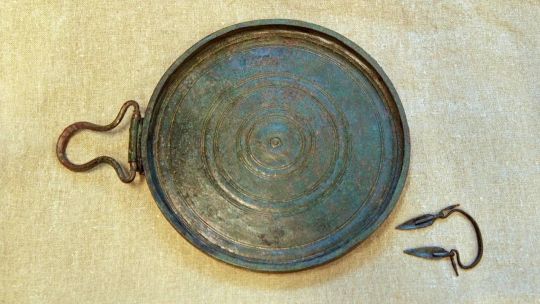
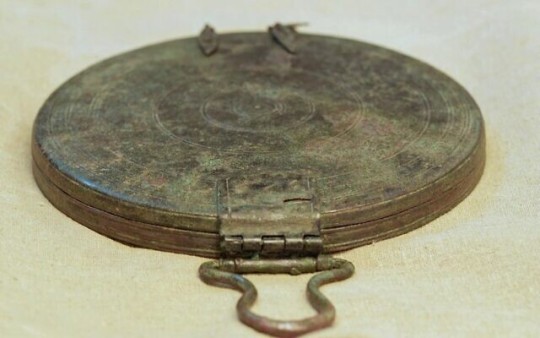

In the Middle East and eastern Mediterranean, the Hellenistic age refers to the period between the death of Alexander the Great in 323 BCE and the conquest of Egypt by Rome in 30 BCE. Stiebel said that he and his team believe the woman would have been among the first Greeks to arrive in the region.
Liat Oz, the director of the excavation on behalf of the IAA, described the mirror found in the tomb alongside the remains.
“This is only the second mirror of this type that has been discovered to date in Israel, and in total, only 63 mirrors of this type are known around the Hellenistic world,” she said in a news release about the discovery.
“The quality of the production of the mirror is so high that it was preserved in excellent condition, and it looked as if it was made yesterday.”
Folding box mirrors such as this were documented in tombs and temples in the Greco-Hellenistic world, the researchers noted. They were usually decorated with engravings or reliefs of idealized female figures or goddesses.

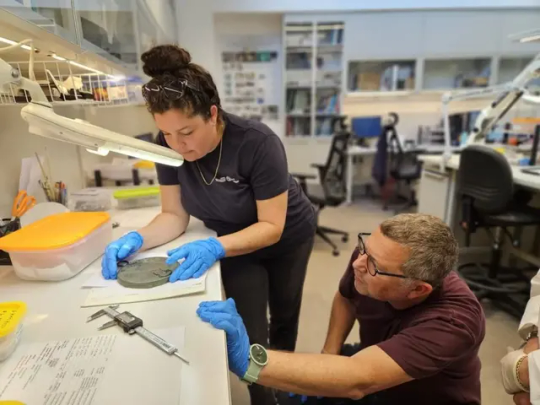
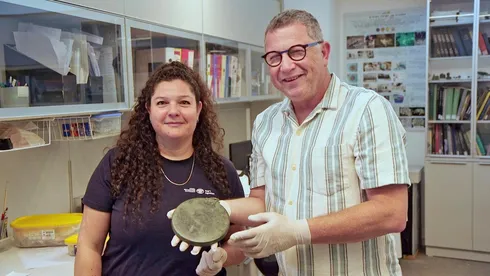
Stiebel said a woman of high status might have received such a mirror as part of a dowry, but this was unlikely to have been the case in this instance as married women rarely left their homes in Greece.
Alternatively, he said, she might have been a courtesan, as they often received gifts from men. Likening the hetairai to Japanese geishas, Stiebel explained that the women were regarded as “muses.”
He said: “Women in society were breaking glass ceilings in very strict and male-oriented Greek society and we do know that they served not only as sexual escorts, but were similar to geishas and provided an element of culture. For that they were given gifts and part of the economy of gifts in Ancient Greece had to do with mirrors.”
The fact the remains were cremated also hinted at the woman’s origins, Stiebel said.
“Cremation is alien to this country and the religion,” he said, explaining that cremation is not only forbidden in Judaism but would not have been practiced by the Persian empire either, which occupied the region at that time.
“The tomb was found in the middle of nowhere, not near any village or farm or settlement, which suggests that she would have been connected with one of the military campaigns and dated to the time of Alexandra the Great or slightly later.



“We are suggesting that maybe she was with one of the generals.”
Stiebel went on to explain the significance of four iron nails found with the mirror and remains.
“Nails were used to protect the deceased and also to protect the living people from the dead. The bodies were literally nailed down to ensure they will not come back to the world of the living,” he said.
Stiebel said that the team are continuing with further research in order to “zoom in” on the finer details of the mirror.
He said: “We hope to shed more light on the origin of the production of the art and maybe shed more light on the history of the owner of the mirror, the general who bought it or where she came from.”
The research will be presented for the first time at an Israeli archaeology conference next month.
By Lianne Kolirin.
#Rare Bronze Mirror Found in 2300-Year-Old Grave of Greek Courtesan in Jerusalem#Ancient Greek courtesan#Kibbutz Ramat Rachel#ancient tomb#ancient grave#ancient artifacts#archeology#archeolgst#history#history news#ancient history#ancient culture#ancient civilizations#hellenistic period#persian empire#greek history
80 notes
·
View notes
Text

I like to imagine ancient Greeks giving Zeus and Heracles tons of lovers in order to explain that they are related to them and give them messy love/ marriage lives but when it came to Perseus they were like “nah him and Andromeda are cute af lets leave them be”.
#there is also this alternative myth we’re Medusa was a courtesan rejected by Perseus which is funny#my boy only has eyes for Andromeda and who could blame him?#greek mythology#ancient greek mythology#greek pantheon#perseus and andromeda#princess andromeda#andromeda#Perseus#perseus and medusa#medusa#Heracles#Hermes
22 notes
·
View notes
Note
Hello dr. Reames, I wanted to ask you, do you know where I can get information about hetairas? Honestly, it's a topic I'm very curious about.
Thank you!!!
There are a couple of at least somewhat recent books to check out.
First is Prisoner of History: Aspasia of Miletus and her Historiographic Tradition by Madeleine Henry (1995). Not necessarily an easy read, but very good in de-mythologizing her.
Second, James Davidson's Courtesans and Fishcakes: the Consuming Passions of Classical Athens (1997) has material on hetairai. It's a good, easy read, and I regularly recommend this to my students. As it's roughly contemporaneous with Henry, I'd actually recommend starting here before tackling the other.
Christ Faraone and Laura McClure edited a very important collection Prostitutes and Courtesans in the Ancient World (2006).
Then we have Konstantinos Kapparis' more recent Prostitution in the Ancient Greek World (2017).
Also see this Project MUSE summary, which gives a lot more historiographic detail on the topic.
#hetaira#hetairai#courtesans in ancient Greece#Aspasia#ancient Greece#sex workers in ancient Greece#prostitution in ancient Greece#Classics#historiography of ancient Greek prostitution#Tagamemnon
5 notes
·
View notes
Text
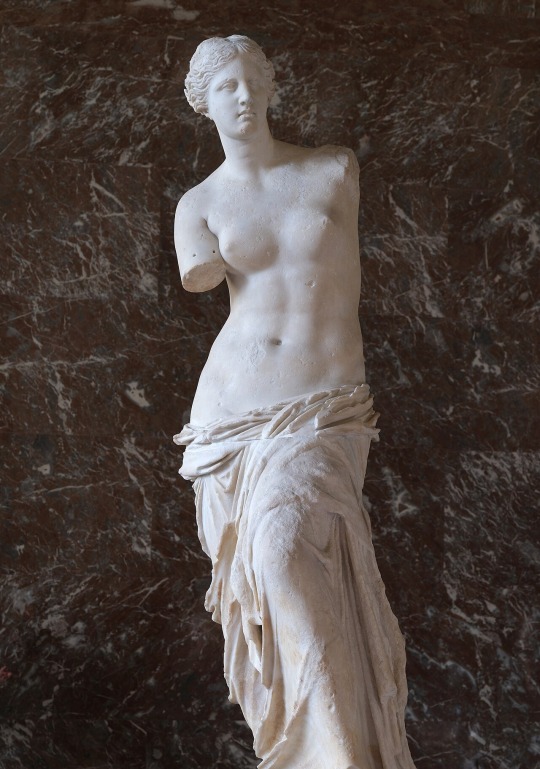
VENUS DE MILO | 150-100 BC |
THE VENUS DE MILO is a masterpiece of ancient GREEK art. Despite missing her arms, this marble statue exudes grace, beauty, and timeless elegance. The sculpture represents the idealized female form of classical antiquity.
The sculpture displays several characteristic HELLENISTIC traits, such as the twisting pose of the body and the sensuality of the figure. The drapery cascades softly around her hips and legs, emphasizing her feminine curves while also concealing her nudity. The statue was originally decorated with jewels, as evidenced by holes in the head, ears, and upper body.
THE VENUS DE MILO'S facial features are delicately rendered, with a serene expression that exudes a sense of inner tranquility and beauty. Though her arms are missing, the statue's enduring allure lies in its ability to captivate viewers with its enigmatic beauty, inviting interpretation and contemplation.
Scholars speculate about the original context and purpose of the VENUS DE MILO. Some believe she may have been created as a representation of the goddess APHRODITE, while others suggest she may have been a portrait of a mortal woman or even a COURTESAN. Regardless of her original purpose, it remains an enduring symbol of feminine beauty and grace.
KENNETH CLARK describes the figure as "the last great work of antique GREECE", and "of all the works of antiquity one of the most complex and the most artful....[the sculptor] has consciously attempted to give the effect of a 2nd-century work, "while also using "the inventions of his own time. "
#venus de milo#greek sculpture#hellenistic sculptures#hellenistic#hellenic pagan#hellenic polytheism#hellenic deities#aphrodite
58 notes
·
View notes
Text

A current illustration that I had for an early celebration of Halloween: Ares dressed up as the famed Roman general, Marcus Antonius, while Aphrodite dressed up as Queen Cleopatra VII Thea Philopathor of Egypt…🎃🍬🍭

I was interested and inspired by the idea that mortals who often dressed as divinities back in ancient times to achieve power, wealth, opulence, and influence, while in this modern-day, divinities often participated in down-to-earth activities, have fun disguising and dressing up as historical mortals for holiday celebrations!!!


Aphrodite’s version of the Egyptian queen was mostly based on the depiction of historically accurate Cleopatra VII made by Joan Francesco Oliveras (@/jfoliveras on Twitter, and Instagram ), as well as statues and statuettes of Isis-Aphrodite that were carved from the Ptolemaic era till the late Roman period of Egypt, albeit taken with modern creative liberties. Isis, during this time, was a very weird figure to say the least, since while still keeping her Egyptian identity and attributes, she was further fused, syncretized, and absorbed the qualities of foreign Greek goddesses like Aphrodite, Demeter, Persephone, Tyche, etc.
With Aphrodite is the fertility goddess of war, love, lust, beauty, passion, and procreation, and later is associated with prosperity, victory, and the ancestral mother of Rome through syncretism with Venus Genetrix; while Isis is the goddess of magic, life, and wisdom, an epitome of eternal maternal devotion, protectress of all living things, from pharaohs to the vulnerable and all aspects of the kingdom, the iconography was adopted by many Ptolemaic queens, particularly Arisnoe II Philadelphos, Berenice II Euergetis and Cleopatra VII.
Ares’ version of Marcus Antonius was based on the historical statue of the Roman politician himself, with his embellishing muscle cuirass based on the Roman Republican statues of Julius Caesar, Augustus (Octavian) of Prima Porta, and Mars Ultor in the Forum of Nevra. With various mistresses (including famous courtesan Cythersis of that time) and marriages to Fadia, Antonia, Fulvia, Octavia the Younger, and Cleopatra VII, their descendants later went to become famous Roman statesmen, or went on to rule the Roman Empire, as well as various clientele kingdoms of modern-day Cimmerian Bosporus, Middle East, North Africa as well. Historically, Marcus Antonius, during his trip to Egypt to visit Cleopatra VII, has always considered himself to be an embodiment of Zeus-Serapis-Dionysus, consort of Isis Aphrodite, but I just think the icon of armed muscular Ares/Mars always suited him more, and look the best.
#ancient greek#ancient egypt#ancient rome#aphrodite#ares#modern day greek mythology#mars#venus#marcus antonius#mark anthony#cleopatra#cleopatra vii#ptolemaic egypt
35 notes
·
View notes
Text

Marble statue of an old woman. x
Roman copy of a Greek work of the 2nd century B.C.
These young girls, linked i
During the Hellenistic period, artists became concerned with the accurate representation of childhood, old age, and even physical deformity. The range of subject matter was extended to include genre-like figures from the fringes of society. Fine, large-scale statues of fishermen, peasants, and aged courtesans became valued religious dedications, sometimes placed in a park-like setting within the sanctuary of the god. Although this statue is known familiarly as The Old Market Woman, it probably represents an aged courtesan on her way to a festival of Dionysos, the god of wine. Her delicate sandals and the ample material in her thin, elaborately draped chiton are a far cry from the rough garb of a peasant woman. The ivy wreath on her head marks her association with Dionysos, and the basket of fruit and the two chickens must be dedicatory gifts to the god or simply her own provisions for a long day of celebration. Veneration of Dionysos was widespread during the Hellenistic period, and ancient literary descriptions give an idea of the extraordinary processions and festivals held in his honor. The flattened composition of the figure is typical of sculpture created in the late second century B.C. The original work may have been dedicated in a sanctuary of Dionysos. The Roman copy could have decorated a garden.
27 notes
·
View notes
Photo

Wine in the Ancient Mediterranean
Wine was the most popular manufactured drink in the ancient Mediterranean. With a rich mythology, everyday consumption, and important role in rituals wine would spread via the colonization process to regions all around the Mediterranean coastal areas and beyond. The Greeks institutionalised wine-drinking in their famous symposia drinking parties, and the Romans turned viticulture into a hugely successful business, so much so, that many of the ancient wine-producing territories still enjoy some of the highest reputations in the modern wine industry.
Wine was drunk on social occasions such as the Greek symposium, or drinking party, where elite male citizens would discuss politics and philosophy and be entertained by musicians and courtesans (hetairai). Special drinking vessels developed such as the shallow stemmed kylix which could easily be lifted from the floor by a drinker reclining on a couch. Large pottery vessels known as kraters were made so that wine could be easily mixed with water. The Roman equivalent to the symposium was the convivium where respectable women were added to the guest list and food had a greater emphasis.
Besides being a tasty drink and social lubricant wine had other functions such as in the pouring of libations to the gods in religious ceremonies. Wine, often healthier than unreliable sources of water, was also sometimes prescribed as a medicine by ancient doctors. This remedy was to be taken in moderation, though, as the ancients early identified the dangers of excessive drinking including insomnia, memory loss, a distended stomach, character changes, and early death. Wine was a gift from the gods but not to be over-indulged in or one would end up meeting them earlier than one hoped.
Continue reading...
45 notes
·
View notes
Text
Criminal Minds characters as Greek Gods: Pt 1
“Of all men’s miseries the bitterest is this: to know so much and to have control over nothing.”
― Herodotus, The Histories
Jj - Aphrodite - Goddess of Love and Beauty
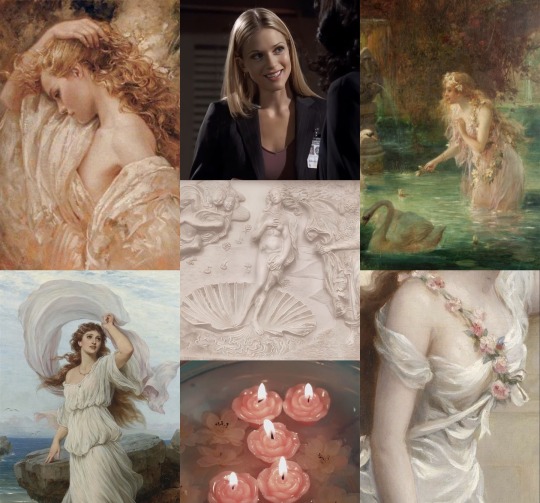
Aphrodite was the Ancient Greek goddess of love and beauty. It is said her appearance was so enchanting to cause substantial conflict among gods and men alike. Aphrodite was honoured as a protector of those who travelled by sea and, less surprisingly, courtesans and prostitutes.
“They wanted you to believe that love is weak, that you cannot curse and kiss with the same mouth. They wanted you to believe that the root of love is romance, soft and wide-eyed...Regardless o whether you desire it, love is what sits at the core of the world."
Emily Prentiss - Athena - Goddess of wisdom and warfare

Athena in Greek mythology was the city protectress and the goddess of war, handicraft and practical reason. As a goddess of war she could never be dominated by any other gods of Olympus. The goddess was not to be trifled with and her sense of justice was such that acts of impiety were swiftly avenged.
“There is always a way out for those clever enough to find it.”
Penelope Garcia - Persephone - Goddess of Spring and Death

The sweet daughter, goddess of harvest and fertility, of goddess Demeter and Zeus, who was kidnapped by Hades and later became the Queen of the Underworld. It is her return to Olympus every six months which causes the flowers to bloom and the harvest to flourish.
"Lost in Hell,—Persephone,
Take her head upon your knee;
Say to her, “My dear, my dear,
It is not so dreadful here."
#criminal minds#david rossi#derek morgan#spencer reid#jennifer jareau#penelope garcia#emily prentiss#greek mythology#greek gods#greek goddesses#greek myth aesthetic#criminal minds x reader#criminal minds fic#criminal minds fanfiction
34 notes
·
View notes
Text

“First you will reach the Sirens, who bewitch all passerby…Around about them lie great heaps of men, flesh rotting from their bones, their skin shriveled up.” -Odyssey, Book 12
“We have lingered in the chambers of sea By sea-girls wreathed with seaweed red and brown Till human voices wake us, and we drown” -T.S. Eliot
The many interpretations of the Sirens! A temptress mermaid with wings, the traditional ancient Greek bird woman with her standard courtesan hairstyle (also I made her bird body an Albatross for Rime of the Ancient Mariner vibes), and two more monstrous versions in mermaid and bird beast forms.
#tagamemnon#artists on tumblr#mermaids#sirens#classics#monster#sea monster#digital drawing#art tag#illustration#oc#sailor knot#classical mythology#mythology#siren#mermaid#Mermay#ship#ocean#sea#rope#skull
10 notes
·
View notes
Text
APHRODITE MASTERPOST

(all sources will be linked in Aphrodites name. UPG post and info post will be marked.)
🦢🥀🦢
I've been worshipping Aphrodite for about four to three months I think?? She's very kind and sweet from what I've seen so far. But anyways here the master post!!
🦢🥀🦢
WHO IS APHRODITE?
Aphrodite is the Greek goddess of love, beauty, compassion, sexual love, (although it is known that Aphrodite rules over other things like war and destruction.) She could entice both gods and men into illicit affairs with her beauty and whispered sweet nothings. Aphrodite was born near Cyprus from the severed genitalia of the sky god Uranus.
Worshipped by men, women, and city-state officials, Aphrodite also played a role in the commerce, warfare, and politics of ancient Greek cities. In addition, Aphrodite was honoured as a protector of those who travelled by sea and, less surprisingly, courtesans and prostitutes. The goddess' Roman equivalent was Venus
In mythology, the goddess was born when Cronos castrated his father Uranus (Ouranos) with a sickle and cast the genitalia into the sea from where Aphrodite appeared amidst the resulting foam (aphros).
Aphrodite has alot of myths and stories about her as well, mg favorite being: ares and Aphrodite, Aphrodite in the trojan war, and Aphrodites and Adonis.
WHAT IS APHRODITES ROLE?
In ancient Greece, Aphrodite played a big role in warfare and city state capitals. But as of today, Aphrodite is useally worshipped as a beauty goddess, her worshippers useally work with her in beauty and glamour spells, and sometimes even baneful.

UPG
Again I've only worshipped Aphrodite for a little bit, but I'm pretty sure she's been following me around for a while, she first presented herself to me around two years ago and ever since then I've felt a very strong connection to the sea. She presents herself to me as a tall naked white glowing figure with pearls running down her body. I think she's absolutely beautiful.
UPG/INFO POST
- Aphrodite infodump (info post)
- Aphrodite info post (info)
- devotional offerings to Aphrodite
10 notes
·
View notes
Text
A clarification on Athenian Laws concerning male homosexuality.
(because this particular small thing is often misunderstood, due to inability to accurately translate specific ancient greek terms into english, or lack of comprehension of context.)
In classical athens, there was a very specific set of laws, concerning ONLY male athenian citizens (so slaves, women and metics were not subject to it). These laws said that a male athenian citizen who engages in intercourse with another man IN EXCHANGE FOR PAYMENT, was not allowed to do certain things, such as hold positions of power or speak in the assembly. There were also potential penalties (not described in detail) for the person hiring an athenian citizen for this purpose. Again, this is often misunderstood, so I have to repeat, this was only when it was done in exchange for some sort of payment/recompense. The word used for these men is of the same root as εταιρα, which was the female counterpart. It is often mistranslated, there's a whole thing I could go on explaining about the different types of prostitution terms, but basically there was a distinction between prostitute and courtesan/escort/whatever you'd call them in english.
Also, this law did not forbid this, and it was not a prosecutable offense by itself. The offense was if one such man disobeyed the limitations set by the law, and it's unclear to me what the deal was with the person who paid.
SO yeh. Next time someone says there were laws against homosexuality in classical athens, here's a helpful article of a guy explaining this much better than me, and goes into more detail about all the weird intricacies of the legal system, as well as the laws set in place to protect boys from grown men:
and here's our original source about these laws:
#tagamemnon#ancient greece#this isn't my field of expertise so if i've misunderstood anything let me know#but this is why I recommend going as close to the original sources as possible#always#because it would've been easy for someone to mistranslate this one term#and someone who doesn't know the context of the entire text#might read that and think all bottoms lost their rights in classical athens or something#which would make no sense because alcibiades was publicly called a bottom in plays which would mean that ppl knew it#(or the joke wouldn't work i think)#but he held the highest possible position for a short while after his recall to athens#also to anyone who says these relationships were only for adult men and teen boys#pausanias and agathon were lover-beloved when they were both grown adults#agathon is around thirty in the symposium#and they even left athens together at the end of their lives#ANYWAYS UR WELCOME HAVE A NICE DAY
87 notes
·
View notes
Note
Because unfortunately the internet doesn't have any lists of famous couples in Greek history aside of course... Greek mythology.. i know of Pericles- Aspasia/ Theodora- Justinian but i am very sure there are many more.
Can you make a list of famous couples in Greek history starting from ancient times until 20th century?
I am not perfectly sure how to approach this though. Are we talking about couples both members of which contributed to history? Or just a famous couple we know existed? Also, is this only about history or does it include famous couples culture-wise? Do they both have to necessarily be Greeks by descent? There are many questions I have but I will give it a try.
Periclés & Aspasia (5th century BC)
Aspasia was the sister-in-law of Alcibiades who brought her too with him in Athens from her hometown Miletus in Asia Minor. Aspasia worked as a high-class courtesan, a hetaera. She is perceived in two different ways by Ancient Greeks: either as a vulgar promiscuous woman or as a philosopher and an intellectual. Maybe the truth was somewhere in between. She had a son with Pericles, the most prominent politician of Classical Athens. It is suggested that Perciles heard her council and took her opinions regarding politics into account.
Socrátes & Xanthippe (5th-4th century BC)
Not exactly a role model of a pairing but a famous one nonetheless. For one, the most famous Greek philosopher, Socrates, must have been a LOT older and his marriage to Xanthippe might have not even be his only one. On the other hand, many sources seem to agree that Xanthippe was a notoriously temperamental person and she would mistreat Socrates, who viewed this as an opportunity to practice the values of patience and forbearance.
Crates & Hipparcheía (4th century BC)
Crates of Thebes was a cynical philosopher, whom Hipparcheia of Maroneia met and fell madly in love with. She insisted that (the unattractive) Crates would be the only one she would be having, leading her wealthy parents to despair. The parents asked Crates to talk her out of it himself and Crates complied! He removed his clothes and showed himself to Hipparcheia, telling her: "That's all you'll be getting in a life with me". He did not phase Hipparcheia one bit and eventually the parents ceded and allowed Crates to marry her. They are notorious for a little too much PDA (they were having sex publicly) which scandalised Ancient Greeks a great deal. Their relationship was one of mutual love and respect and living on equal terms together. Hipparcheia not only embraced but started practicing philosophy and totally immersed herself in the respective lifestyle of cynicism as well.
[???] Cleopatra & Antonius (1st century BC)
I don't know if they count since Antonius AKA Mark Antony was not Greek, however Cleopatra was a member of the Macedonian Ptolemaic dynasty of Egypt and their story essentially sealed the Greek future. Mark Antony was a Roman general who opposed to Julius Caesar´s assassins and allied with the latter´s relative Octavian. Later, however, their relationship was strained leading to a form of civil war in the Roman Empire. The reason was that Mark Antony had a long affair with the Queen of Egypt Cleopatra, even had three kids with her, and now favoured promoting Caesarion (Cleopatra´s son from her past affair with Caesar) to the Roman throne instead of Octavian. Mark Antony was defeated by Octavian in the Battle of Actium in Greek territory and then again in the Battle of Alexandria. Knowing there was no hope for them at this point, Cleopatra and Antonius committed suicide together and this generally is viewed as the "official" end of any form of Hellenistic hegemony in the now completely Roman empire.
[???] Justinian & Theodora (5th - 6th century AD)
The question marks are because Theodora was of Greek descent but Justinian was not. Justinian was one of the most successful emperors of the East Roman / Byzantine Empire, making it reach its widest borders, including "reconquests" of the fast dissolving Western Roman Empire. He also achieved or rather imposed the peace in the internal affairs of the empire, sometimes with the use of a lot of violence. It is believed that he was very influenced by his wife Empress Theodora, who was hardened by her very humble origins (she was likely a prostitute). Theodora was extremely strong-minded and contributed a lot to the strong image built around her husband. Furthermore, she contributed to the making of laws for the improvement of the position of women in the society. Most sources agree Justinian was crazy for her, while it is uncertain whether Theodora was loyal to him.
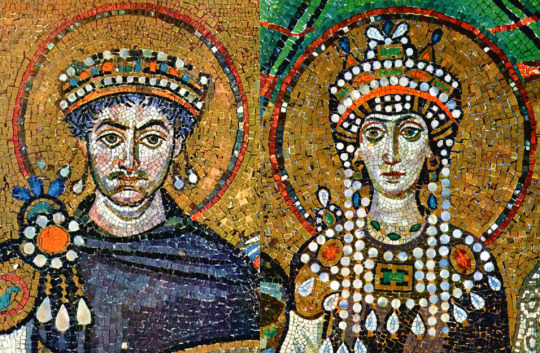
Surviving mosaics of Justinian and Theodora in a Byzantine Church in Italy.
Kassianí and Theóphilos (9th century AD)
These two have become a romance in legends more than they might have actually been in their real life. Still, their affair or lack thereof, technically, has a significant enough impact on Greek and Greek Orthodox culture so they should be mentioned. The Byzantine Emperor Theophilos invited all the prettiest maidens of the empire to his court in order to pick a wife. Amongst them, Kassiani was the one who stood out both in looks and intellect. The emperor stood before her and offered her a golden apple, token of his affection and proposal. It is totally unclear what was happening in Theophilos' brain at the moment but of all things he could say to impress her, he chose to tell her something very sexist. Kassiani ended him on the spot with her response and did not take the apple. The emperor, humiliated in front of all his court, gave the apple to Theodora (another one!), another fine lady standing next to Kassiani. For all we know, this could be the end of it. But Kassiani's choice to never marry and isolate herself in a monastery instead has created legends and speculations that it was due to her heartbreak. In any case, Kassiani proceeded to become the most (or only) significant female psalm composer and poetess in the history of the empire and her psalms and hymns are used in the Service of the Orthodox Church during the Holy Week of Easter. Meanwhile, Theophilos fell ill early in his life and died young. It is said / speculated that when he felt death was near, Theophilos visited Kassiani in her monastery to see her one last time. Kassiani saw his carriage approach and hid herself in a closet to avoid the temptation. Theophilos entered her cell and saw nothing but the psalm she was composing at the time on a table. He read it and added the last line himself. He understood she was hiding from him, respected this and left. Kassiani got out, read the hymn and kept Theophilos' addition. Since then, the last verse of this hymn is attributed to Theophilos. For more about Kassiani and what exactly were the notorious exchanges they had that separated them as well as how the content of this hymn is essentially what led to these speculations, read this older post I had made.
Mantó Mavroyénus & Demétrios Ypsilantis (19th century)
A romance that flourished amidst the years of the Greek Independence War. Demetrios led many of the battles against the Ottoman army, however he is a little overshadowed by the more tragic story of his brother, Alexander Ypsilantis, who was the overall leader of the Friendly Society (the secret organisation which plotted and spread the fervor for the Greek Revolution). Meanwhile, Manto was the daughter of a wealthy aristocratic Greek expat in Italy, who was also a member of the Friendly Society. When the war broke out, Manto first tried to raise awareness about the Greek cause in France. Soon, she departed for Mykonos island, the place of her descent, with a large part of her fortune. She bought ships and created her own fleet, sending them and her men to many battles in the islands. She later participated in several battles in mainland Greece as well. There she met Demetrios and they got engaged. She became renowned in all of Europe at the time for her beauty and activity. The couple was in love and they were adored by the Greeks, who really liked that union of brave noble Greek role models. A prominent and very corrupted politician, Ioannis Koletis, did not share the sentiment. Fearing that the couple was gaining too much power and influence over the public, that could eventually turn political, he started a relentless defamation of Manto to her fiancé. He spread his lies so that Manto's reputation was ruined. Ashamed, Demetrios broke up with her. Manto returned to her home island heartbroken and penniless as she had given all her fortune for causes of the war. After the official indepedence of the Greek state, the enlightened governor Ioannis Kapodistrias restored her reputation and gave her the honorary title of Lieutenant general. Around the same time, Demetrios passed away young as he had always frail health.

Penelópe Delta & Ion Dragumis (19th - 20th century)
A famous love story rather than a couple. Ion Dragumis was a prominent young politician and the biggest adversary of the famous Greek politician Eleftherios Venizelos. He was very sophisticated, seductive and a smooth womanizer. He drew the attention of the slightly older author Penelope Delta, who at the time was already a mother of three. Delta fell so madly in love that she had the guts to reveal the truth to her husband and ask for a divorce. Her husband refused, trying to protect both his and her reputation. However, Delta's passion for Dragumis was so fierce that neither the husband nor her father could fight it. They eventually gave her an ultimatum that she had to choose either her children or leave the children to the father and go away with Dragumis. Delta chose to stay with her children but her desire was such that she attempted suicide multiple times. Meanwhile, Dragumis went on with his life and started an open affair with the famous actress Marika Kotopuli, without any intent to marry, which was very scandalous for the time. When Delta heard of this affair she started dressing in black, as if in grief, and kept doing it until the end of her days. At some point, there was an attempt at an assasination of Venizelos in Paris. Fanatic supporters of his in Athens, believing mistakenly that his big adversary Dragumis was behind it, trapped him and shot him in the middle of a street. Delta dedicated some of her later activity to sort out and copy a lot of Dragumis' drafts full of thoughts and ideas, that his brother had entrusted with her. Apart from this, Delta kept writing novels that made her the most prominent female writer of her time in Greece. She had reached her sixties when, in 1941, the Nazi Germans invaded Athens. On that day, she finally committed suicide by drinking poison. For more details, read this older post about Ion Dragumis' love life.

Kostas Karyotakis & Maria Polyduri (20th century)
Two young people, brought apart by their very different personalities and brought together by the fact that they both happened to be poets. The young couple fell madly in love. Karyotakis was a very timid and bashful man, full of insecurities and suicidal thoughts. On the other hand, Polyduri was a raging emancipated extrovert, which caused judgement at the time. Although they were very much in love and dreamed to elope together, Karyotakis was afraid of the bold lifestyle of Polyduri and the judgement it caused. When the girl even took the initiative to propose to him, the young man was so taken aback and panicked that he lied to her that it was no use, because he suffered from syphilis and therefore they should not consumate the marriage. Polyduri did not believe him but she was very heartbroken by his rejection. She departed for Paris where she continued her bohemian lifestyle, maybe taking it too far, until they found her unconscious in a narrow alley. She was diagnosed with tuberculosis and was taken to the sanatorium in Athens. As she was fighting for her life, she learnt that in her absence her past lover had finally committed suicide. His suicide note is very famous, as he describes how he initially tried to kill himself by drowning in the sea but failed because he was a skilled swimmer. He resorted to a pistol. The tragic news had very adverse effects on Polyduri's fragile health. A friend of hers, maybe taking pity on her, handed her injections of morphine, with which she ended her life as well. She has left a suicidal poem, which confirms that grief was the reason she took her life.
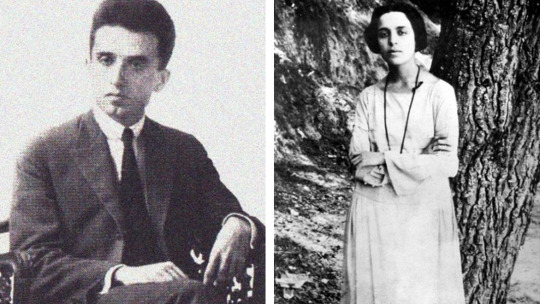
Maria Callas & Aristotle Onassis (20th century)
A very dark couple but the lovers were two of the most internationally well known Greeks of the century. Maria Callas was a Greek American who distinguished herself for being the most famous soprano in the history of Opera. She was born in the USA to Greek parents but soon they were divorced and little Maria followed her mother and sister in Greece where she received her operatic training. Later, she spent most of her time in Italy and France for her career where she enjoyed huge success and glory. She became a symbol of music and finesse. Despite all this, Callas was a tortured soul because she constantly felt unloved and exploited, both by her family and her Italian husband at the time. She suffered from great insecurities and was often deeply melancholic. Meanwhile, Aristotle Onassis was a Greek from Smyrna (now Izmir, Turkey) whose family experienced the atrocities of the Great Fire of Smyrna (in Greek known as Asia Minor Catastrophe). He emigrated to the Americas and started building a colossal business and fortune. He became one of the globally most well known tycoons by accumulating the largest privately owned shipping fleet. His power was immense. He was insanely ambitious and wanted to taste and own all the finest things in the world. He was impressed by Callas and courted her, although he was still married to his first wife. Callas succumbed and broke up with her husband. It was certainly a status affair, however Callas saw something in him, maybe his intelligence, his ambition, that made her fall in love with him deeply. She was pushing for marriage, as she ultimately dreamt to have kids and a conventional love life but Onassis was giving her the hot and cold treatment. One day, Maria Callas famously turned on the TV in her apartment, only to see in the news that Onassis had married the widow of American president John Kennedy. I can only imagine the impact learning such a thing from the news had for the sensitive psyche of Callas. Onassis went mad with the sense of status it gave him to marry the wife of the American president. However, he never loved Jackie and they barely even interacted in their marriage. Onassis would often pay visits to Callas which did no good to her but she found it very hard to resist him even though he made her sadder and sadder still. Despite all his cleverness and strategies, Onassis became miserable with tragedies that struck his family, so much that there is a talk of the "Onassis curse", generally insinuating that he was paying for his wrongdoings. Onassis could not suffer the untimely death of his son and his health deteriorated fast. Callas visited him in his deathbed and there were sources claiming he expressed his regret to her. Callas too had a very fragile health for many years. His death is believed to have contributed to her own premature death from a heart attack two years later.

King Constantine II of Greece & Queen Anne-Marie of Greece (20th - 21st century)
Because the majority of Greeks have no positive views about the constitutional monarchy, this may seem like an odd choice, however the truth is that before the graceless fall and exile of the king, the young royal couple was adored by the Greek public because it was viewed as the quintessential romantic image of a royal fairytale. He was young and super handsome, she was super beautiful and graceful, he was the Greek king, she was the Danish princess. Their marriage may have been one of the most grande events that took place in Athens in the 20th century. The media were delirious, one magazine declaring how "we" had the most beautiful royal couple in the world and, you know, as bold a statement as it may seem, it was perhaps not far from the truth. The image of the king was forever ruined after his catastrophic choices to tolerate the Greek dictatorship and then organize a childish coup against it. The fallen royal family lived in exile for the following decades - and we can accept that they sincerely resented this - until the ex-king was allowed back in Greece in the 00s. Regardless of anything else, the two of them were a rare example of marital success and mutual devotion in the royal circles. Despite all the drama and resentment against Constantine and the institution of monarchy, the Greeks retain respect for former Queen Anne Marie, who remained graceful all this time, viewed as a perfect role model of a wife and respectable royal. Constantine passed away a year ago.

They were literally Disney.
Aliki Vouyouklaki & Dimitris Papamichaél (20th century)
I thought of ending this with a celebrity couple, certainly the most famous Greek celebrity couple. Much like it happens in such cases, the image was so very bright but the truth was darker. Despite all the toxicity, it is generally believed Vouyouklaki and Papamichael were each other's love of their life. Vouyouklaki and Papamichael were the most promising and charismatic actors of their generation. They were in the same theatrical school and developed a love-hate relationship with constant bickering. When they rose to stardom, they simply tranferred this energy to the movies they starred in together, which led to great success and immense adoration from the Greek public. Aliki Vouyouklaki retains the title of the "national star". When the two got married, their fans were losing their minds. The marital life was not peaceful as their youthful bickering had now transformed into the much darker career competition. Papamichael was a very conservative man and he was poisoned of feelings of injustice and envy when Vouyouklaki attracted more attention and acknowledgement than he did, because he thought of himself a better actor than she was. Now, that was generally true, Papamichael was a great actor with a big range for comedy and drama. Vouyouklaki has posthumously been accused of bad acting, however this is not entirely fair. She was indeed bad in drama but she was exceptional in comedy. A problem that could negatively affect her performances was that she refused to spoil her looks for a role, no matter how essential it was for the plot. Anyway, the marriage was often violent and neither of the two ceded to the other, as Vouyouklaki was extremely sharp and refused to sacrifice anything from her image, her career and her decency. Eventually, they broke up in a bad way as well. Both went on with their lives but Papamichael found it harder to cope without her. In later years, they reached a sort of mutual understanding and formed a platonic friendship of sorts. Aliki Vouyouklaki was prematurely diagnosed with pancreatic cancer. In her deathbed, Papamichael would visit her and lament, and implore her to rise and go away together. After her death, which shocked and deeply grievened all of Greece, Papamichael would regularly visit her grave for the rest of his life.

And one from when they were far less glamourous but finally healthily loving / respectful to each other, with their son, because I want to end this on a good note.

Is this an early Valentine post? lol idk it takes some serious left turns
#greece#europe#history#greek history#ancient greek history#byzantine greek history#modern greek history#culture#famous people#greeks#greek people#greek culture#anon#ask#long post#long text#tw long#cw violence#cw abuse
16 notes
·
View notes
Note
Do you know of the Ancient Greek courtesan who was on trial but was pardoned because she flashed the court her breasts and said some Mr hint along the lines of “it would be a crime to destroy these perfect creations.”
You cannot tell me that this doesn’t have LL Giant ! Liaison shenanigans written all over it!
(Thank you, anon, for that joy. Humans be humans, even thousands of years ago. For anyone else's interest, it's Phryne the Thespian. Her beauty was so famed that she is credited to inspire many influential works, such as Praxiteles' Aphrodite of Cnidus and Apelles' Aphrodite Anadyomene. In that trial, she was acquitted when her breasts were exposed. It was argued her great beauty was shaped by the Gods, so it would be blasphemous to kill or imprison their work.)
You're jogging after Ultra Magnus' back. Despite your increased size, that mech is still massive with long legs that ate the ground with each quick step.
He quickly gets you inside the captain's office and immediately locks it down. Rodimus is at his desk, datapads all over the place, even on the floor, and he brightens up at visitors, hands stopping from carving deeper into the desk.
Ultra Magnus' clears his intake in a very pointed manner, chin darting to a specific point in the room.
"Roddy, what the fuck!?"
Over the fish tank, there's a new portrait. Back home, it wouldn't be too risque. Something on the scale of sexy pin-up on a magazine cover in the grocery store, but you've been around Cybertronians long enough that it's considered hedonistic.
It's set inside of a car alt-mode with the obvious Autobot insignia on the steering wheel and sprawled across the front bench seat is the focal point.
From their standards, there's an obscene amount of fabric, a rich Autobot-red, pooling beneath bare legs and caressing the plush leather. The legs are bent and thrown across the dashboard and seat, and sharp high-heels bite into the leather, showcasing pressure and leverage as the other is resting through the wheel. The artist is familiar enough with the concept of nail polish since the same vivid red is painted across toes and fingernails.
The top of the garment is being loosened with one hand pulling it to the side, flashing and teasing with more bare flesh covered with lace, ribbons hanging loose. A gloved hand is about to pull off the tactical mask. A slow, sensual tease of contradiction. Vulnerable and willingly taking off the only protective piece.
Even with the obscured face, it isn't hard to figure out it's you.
You are, quite literally, the only human on board the spaceship, and the fucking subject is a human with your damn heels you used in one of the modeling classes.
"You like?" Rodimus' spoiler bounces excitedly. "Sunstreaker said I'm getting better with movement, and it's my best work yet!"
"There's more," you and Ultra Magnus' words overlap with different tones: curious disbelief and resigned trepidation.
Of course, Rodimus pulls out a datapad from the bottom, the stack wobbling dubiously before settling, and rushes over to show off his progress.
"Rodimus," Ultra Magnus sighs. "this is against the Autobot Code: Article-"
"Wait!" You interrupt, stalling from flipping through more sketches of your poses and his random exercises. "There's rules about that?"
"Yes," the ever-serious Duly Appointed Enforcer spoke.
"Yeah, but Article 369 is about commercialized pieces, Mags." Rodimus crows, pointing at his work with a thumb. "And that beauty is done by my own servos."
You and Ultra Magnus shared a moment that Roddy could look up official doctrines, and the taller mech deeply sighs. "No. It violates the article 343 on the conduct of offices. As well as Article 34 for the violation of improper licensing on artistic production."
You're seeing the loophole that a "scandalous" piece can be placed in a private setting that isn't for public view, but you're not saying anything about that.
#ask#transformers#transformers idw#idw#mtmte#ultra magnus#rodimus prime#rodimus#reader insert#cybertronian culture#culture clash#art modeling#tf headcanons#my writing#Roddy is ridiculously proud of that piece
77 notes
·
View notes
Note
hello! I read you're "predominantly a Romanist" so I'm not really sure if you can help me but I have this question bugging me for weeks and I thought some clarity from people more expert than me could probably be insightful, so here's the tea: many generations of Italian high schoolers have been taught that Sappho was the headmaster of some sort of college (the term used in lit history books is "thiasus", but I'm 99% sure this is some wild anachronism, and that if such institution even existed it was certainly not called that); according to Ye Olde Books, this thiasus was some sort of bon ton academy to prep young girls for womanhood and marriage, and Sappho's homoerotic poetry must be therefore viewed through this "socratic" lens. Herein lies the issue, that while there seems to be no ancient evidence to prove or disprove this fact, every Italian schoolbook I've stumbled upon either in high school or university never provided a source for this (they all mention the Souda which is problematic in itself, but even there it's only said that her pupils were so and so and so, not that she was actually the head of any formal institution). Plus, looking over on wikipedia, the Italian one takes the thiasus claim at face value without even giving a source (again), while the English wikipedia goes at a length to explain that this idea has no historical grounds and it's just a xix century suggestion. I've even stumbled upon this Maximus Tyrius rhetorician from the second century and he quotes Sappho's views on love and the women she loved, without explicitly saying they were her pupils or part of an academic circle.
So, here's my question: is this concept actually still taught in the Anglo world, and is there any substantial evidence for it? Is it just a weird little straightwashing lie that is still taught in my home country to try and justify any homoerotic reading of the Lesbian, or is there possibly any truth in it?
Sorry for the long ask but I'm going kinda insane here, and i thought one thing i could do is hear from some non Italians cause it's clear to me that all Italian texts are more or less a copypaste of each other on this subject; if you could please tell me anything about this I'd be so thankful, thanks a lot xoxo
Hello! It's been a minute since I've been seriously engaged with Sappho scholarship, but this is something I am familiar with.
The short answer is, no, as far as I know there is no real ancient evidence for it and the concept has generally been regarded as debunked in English-language scholarship since the 90s. The oldest source we have for the concept is the 10th c. CE Souda, which (as you mention) is deeply problematic for a variety of reasons, and it seems probable that the idea of Sappho's thiasos originates with one of the many Greek comedies about Sappho (Sappho was something of a stock character in Greek comedy, with the joke typically being her excessive (hetero-)sexuality rather than homosexuality). The idea seems to have been picked up by 19th century German scholars, and the argument for it relies on the testimony in the Souda along with apparent parallels between Sappho's expression of homoerotic desire and the homoerotic language between women and girls in Alcman's parthenaia, which do have a context of chorus trainer/trainee relationships. However, there is probably no good reason to assume that Alcman/Sappho parallels make for a strong argument considering that the texts come from entirely different city-states and social contexts. I do know that Renate Schlesier has argued for a much less heteronormative and IMO more plausible version of the thiasos idea, which is essentially that the circle of women mentioned in Sappho's poetry is not any kind of "academy to prepare (aristocratic) young women for marriage" but a circle of enslaved sex workers/courtesans (hetairai). Schlesier cites the fact that the female personal names mentioned in Sappho's poetry are all names that would typically be associated with enslaved women and hetairai, at least prior to the Hellenistic period, and considering that the symposium was probably the main venue for the performance of erotic lyric in antiquity this seems to make a good deal of sense.
I won't recommend the article that essentially debunked the thiasos idea on account of its author being a truly awful person for unrelated reasons, but I would recommend this excellent Eidolon piece on "Re-Queering Sappho" as well as Melissa Mueller's 2021 chapter "Sappho and Sexuality" in The Cambridge Companion to Sappho (link here, but probably requires a library subscription) which covers the history of the idea very well and presents a compelling reworking of the idea of Sappho's circle in a way that embraces rather than resists the queerness of Sappho's poetry.
8 notes
·
View notes
Photo

Korea: Kisaeng entertainer and courtesan, c. 1900
Kisaeng (also spelled gisaeng), sometimes called ginyeo (기녀), refers to female Korean entertainers similar to the Japanese geisha and the ancient Greek hetaerae. Kisaeng were not prostitutes but, rather, artists. Although many casual observers mistook kisaeng as prostitutes in Korea, kisaeng entertained aristocracy or royalty, such as the yangbans and kings, as artists.
First appearing in the Goryeo Dynasty, kisaeng served in the government as entertainers, required to fill a variety of roles. In addition to entertainment, those roles included medical care and needlework. Many worked in the royal court, but they also served throughout the country. They received careful training, frequently achieving accomplished in the fine arts, poetry, and prose, although nobility often ignored their talents due to their inferior social status.
Kisaeng, both historic and fictional, play an important role in Korean conceptions of the traditional culture of the Joseon Dynasty. Some of Korea's oldest and most popular stories, such as the tale of Chunhyang, feature kisaeng as heroines. Although the names of most real kisaeng have been forgotten, history records a few for outstanding attributes, such as talent or loyalty. Kisaeng Hwang Jin-i represents the most famous.
continue reading...
37 notes
·
View notes
Text
Don't know if the sites will let this quiz exist, but take it if you want.
#uquiz#uquizzes#submission#long uquiz#differing contrast background#aspec friendly#no quote lyrics#undescribed images#my results:Neaera
26 notes
·
View notes